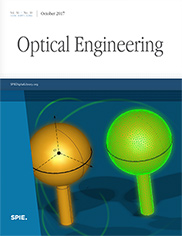Improving partial wetting resolution on flexible substrates
An article in the SPIE journal Optical Engineering presents a two-step manufacturing process for polymer optical waveguides.
 The increasing amount of data used for communications applications, fabrication of optical networks, and bus systems is a challenging task for production engineering. In particular, applications such as automotive, aviation, and industrial, benefit from high electromagnetic compatibility and low weight.
The increasing amount of data used for communications applications, fabrication of optical networks, and bus systems is a challenging task for production engineering. In particular, applications such as automotive, aviation, and industrial, benefit from high electromagnetic compatibility and low weight.
The article "Improving partial wetting resolution on flexible substrates for application of polymer optical waveguides," recently published in Optical Engineering, presents a two-step manufacturing process for polymer optical waveguides.
"The paper shows that the two-step process is suitable for the production of high-quality optical waveguides by means of flexographic printing and a subsequent spray application," says Maurizio Ferrari of Istituto di Fotonica e Nanotecnologie (Italy) and associate editor of Optical Engineering. "Due to the achievable optical characteristics and the efficient production at the same time, the process for the foil-based fabrication of optical networks and bus systems is a promising technology."
Fig 1. Experimental setup of the proposed upgradable RoF transport system.
The authors point out that by improving the highly efficient flexographic printing technology by laser functionalization of the printing tool in combination with a subsequent spray application, high-quality waveguides can be created. By adjusting the resulting surface energy of the foil substrate in the first fabrication process, the spray application achieved high-aspect ratio waveguides with a low attenuation of 0.2 dB∕cm at 850 nm.
Due to the achievable optical characteristics and the efficient production at the same time, the process for the foil-based fabrication of optical networks and bus systems is a promising technology. By further increasing the resolution of the printing process by means of laser beam-functionalized printing forms, smaller waveguide cross sections up to single-mode dimensions can also be realized in the future.
In addition, the full potential of the efficient process chain is given by the thermoplastic substrate, since in this way spatial optomechatronic interconnect devices can also be produced.
The work is presented by Gerd-Albert Hoffmann, Tim Wolfer, Thomas Reitberger, Joerg Franke, Oliver Suttmann, and Ludger Overmeyer, from Leibniz Universität Hannover, Laser Zentrum (Germany).




